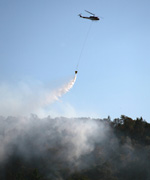 The conflagrations in Southeast Oregon have not yielded a big uptick in business for private firefighters and equipment operators.
The conflagrations in Southeast Oregon have not yielded a big uptick in business for private firefighters and equipment operators.
BY PETER BELAND
 The wildfires that have ravaged over 700,000 acres of land in southeast Oregon have required rapid mobilization of hundreds of firefighting personnel and resources, with private contractors playing a significant role.
The wildfires that have ravaged over 700,000 acres of land in southeast Oregon have required rapid mobilization of hundreds of firefighting personnel and resources, with private contractors playing a significant role.
On the evening of Sunday, July 9th, Melissa Powers, Bureau of Land Management Vale district administrative officer, heard about a fire that had broken out and grown to around 1,500 acres. When she got her team together the next morning to plan out a containment strategy, the fire had grown to 20,000 acres. (The Long Draw fire would eventually grow to over 500,000 acres).
Powers’ office normally has roughly 100 permanent staff with an additional 100 seasonal workers in the summers. After a series of staff transfers, she’d eventually have 100 additional BLM fire management staff to help manage the conflagration.
But even with the additional staff, it still wasn’t enough to handle the deluge of contracts. So Powers eventually called on the help of a Forest Service administrative payment team. Their main task? Managing contracts with private operators.
“Every piece of equipment has a separate payment contract, we already have a full plate,” says Powers. “We rely heavily on contractors…all the way from engines to…caterers.”
Despite the demand, the recent Oregon wildfires are not necessarily having a big impact on the local fire fighting industry’s bottom line. That’s in part because many private firms, especially equipment operators, enter into long term contracts with government agencies. Home to roughly two thirds of the nation’s private firefighting resources, many contractors also do steady business out of state.
Five years ago, the Forest Service used to rely exclusively on “call in” helicopters to help fight fires, said Dan Sweet, spokesperson for Aurora- based Columbia helicopters. But today, Sweet says, the forest service relies more heavily on “exclusive use contracts”: long term agreements in which private companies such as Columbia give government agencies control of equipment.
For example, Columbia operates across the western United States, with four of its 21 helicopters on a exclusive use contract with the Forest Service this year and one on-call. The four exclusive use helicopters have been all over the western states this season and only recently have come to Oregon.
The long term contracts help companies such as Columbia compensate for the erratic, somewhat cyclical nature of wildfires in the West, Sweet said.
Greyback Forestry, an Oregon firefighting company, has been doing a brisk business fighting conflagrations in Colorado and Wyoming, said president Michael Wheelock. But the company didn’t send many crew members to Southeast Oregon, he said. That’s in part because the fast spreading grass and brush fires are best contained via helicopter, not ground crews, he said.
Both Wheelock and Sweet emphasized that the local fire fighting season was just getting started. “Last year was the second or third year that was quiet,” says Sweet. “We’re only part way into it…this could be an active fire season for Oregon.”



